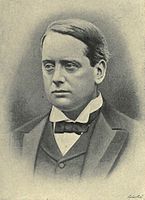Liberal government, 1892–1895
| Fourth Gladstone ministry | |
|---|---|
| 1892–1894 | |

Gladstone (c. pre-1895)
|
|
| Date formed | 15 August 1892 |
| Date dissolved | 5 March 1894 |
| People and organisations | |
| Head of state | Victoria |
| Head of government | William Ewart Gladstone |
| Member party | Liberal Party |
| Status in legislature | |
| Opposition party | Conservative Party |
| Opposition leaders |
|
| History | |
| Election(s) | 1892 general election |
| Legislature term(s) | 25th UK Parliament |
| Predecessor | First Salisbury Unionist ministry |
| Successor | Rosebery ministry |
| Rosebery ministry | |
|---|---|
| 1894–1895 | |

Rosebery (c. pre-1895)
|
|
| Date formed | 5 March 1894 |
| Date dissolved | 25 June 1895 |
| People and organisations | |
| Head of state | Victoria |
| Head of government | Lord Rosebery |
| Member party | Liberal Party |
| Status in legislature | |
| Opposition party | Conservative Party |
| Opposition leaders |
|
| History | |
| Legislature term(s) | |
| Predecessor | Fourth Gladstone ministry |
| Successor | Second Salisbury Unionist ministry |
In the 1892 general election, the Conservative Party, led by the Marquess of Salisbury, won the most seats but not an overall majority. As a result, William Ewart Gladstone's Liberal Party formed a minority government that relied upon Irish Nationalist support. On 3 March 1894, Gladstone resigned over the rejection of his Home Rule Bill and the Earl of Rosebery succeeded him.
Cabinet members are listed in bold face.
...
Wikipedia
